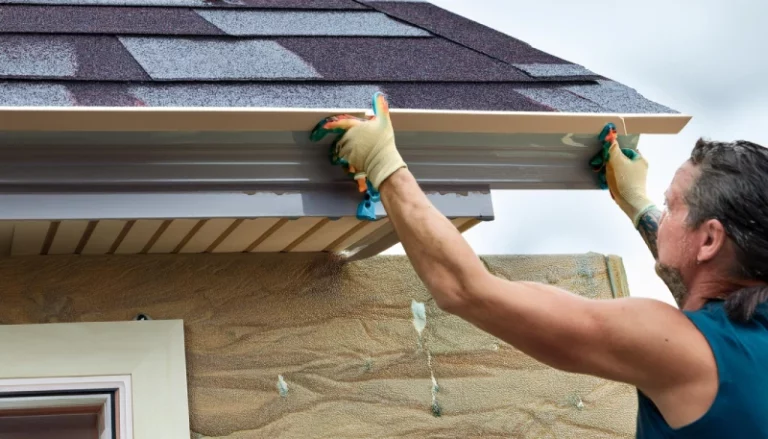45-Degree Vinyl Siding Corners: Your #1 Installation Secret
You’ve planned your vinyl siding project meticulously. You have your panels, your starter strips, and your standard 90-degree corner posts. Then you get to that bay window or modern architectural feature and it all comes to a screeching halt: a 45-degree corner.
Suddenly, that standard corner post in your hand feels useless. This unexpected angle is one of the most common stumbling blocks for DIYers and even some professionals, turning a straightforward job into a complex puzzle. Don’t worry; you’re not the first to face this challenge, and there is a definitive solution.
You'll Learn About
Why Your Standard Corner Post is a Nightmare on 45-Degree Angles
The core of the problem is simple geometry. Standard outside corner posts are manufactured with a fixed 90-degree angle to fit the vast majority of home corners. Trying to force this rigid piece onto a 135-degree outside angle (which is what a 45-degree turn creates) is physically impossible without causing major problems.
Attempting to bend, cut, or otherwise manipulate a 90-degree post will lead to buckling, unsightly gaps, and a compromised seal against moisture. This isn’t just an aesthetic issue; it creates a weak point where wind and water can penetrate your home’s exterior, leading to much bigger headaches down the road.
The Common “Fixes” That Actually Make Things Worse
In the face of this problem, many people turn to makeshift solutions that seem clever at first but ultimately fail. These methods often look unprofessional and can lead to long-term damage, turning a cost-saving measure into a costly repair.
The Ugly Double J-Channel Method
Perhaps the most frequent “solution” you’ll see is using two pieces of J-channel placed back-to-back to create a corner. While this might seem like a logical alternative, it’s fraught with issues. This method leaves a visible, unprofessional-looking seam right on the corner of your house.
More importantly, it doesn’t provide the same structural rigidity or water resistance as a dedicated corner post. The seam is a prime location for water to get in, and you can’t rely on caulk to solve the problem long-term. Remember, using the wrong components can lead to bigger issues, much like how many people mistakenly believe it’s okay to use J-channel at the bottom of siding, which is a huge mistake.
The High-Risk Miter Cut
Another tempting but dangerous approach is to forget a corner piece altogether and simply miter-cut the siding panels themselves at a 22.5-degree angle to meet at the corner. This requires an incredible level of precision that is difficult to achieve consistently, even for experienced installers. Any small error results in a visible gap.
Furthermore, this technique leaves the cut edges of the vinyl exposed. It’s nearly impossible to create a durable, waterproof seal, and this method will almost certainly void your siding manufacturer’s warranty, leaving you without protection if the product fails.
The Professional Secret: Use the Right Part for the Job
The real solution is surprisingly simple: use a purpose-built 45-degree outside corner post. Many homeowners and even some contractors are unaware these specialized pieces exist. They are designed by siding manufacturers to perfectly match the profile and color of your siding while fitting the unique angle of a bay or bow window.
Using the correct component eliminates all the guesswork and risks associated with improvised solutions. It provides a clean, factory-finished look that is both aesthetically pleasing and, most importantly, completely watertight. It integrates seamlessly with your siding panels, maintaining the integrity of your home’s exterior cladding.

Your Step-by-Step Guide to a Perfect 45-Degree Corner Installation
Installing a 45-degree corner post is very similar to installing a standard one. The key is careful preparation and adhering to the fundamental principles of vinyl siding installation, such as allowing for expansion and contraction.
Step 1: Gather Your Tools and Materials
Before you begin, make sure you have everything you need. This includes the 45-degree vinyl corner post, a tape measure, a level, tin snips or a fine-tooth saw, a hammer, and galvanized roofing nails (at least 1-1/4″ long). Having the right tools on hand prevents delays and ensures a quality installation.
Step 2: Measure and Prepare the Corner
Measure the full length of the corner you need to cover. Transfer this measurement to your 45-degree corner post. When installing, you must leave a 1/4-inch expansion gap at the top where the post meets the soffit or roofline. This gap is critical to prevent the vinyl from buckling during hot weather.
Step 3: Position and Fasten the Corner Post
Position the post on the corner, ensuring it is plumb (perfectly vertical) using your level. Place your first nail at the very top of the uppermost nailing slot on both sides. This nail will support the weight of the post while allowing it to hang freely.
For all subsequent nails, drive them into the center of the nailing slots, placing one every 8 to 12 inches. Crucially, do not nail them tight. Leave about 1/32-inch of space (the thickness of a dime) between the nail head and the vinyl. This allows the post to expand and contract with temperature changes.
Step 4: Install the Siding Panels
With the corner post securely in place, you can now install your siding panels. Measure and cut your panels to length, ensuring they are long enough to fit into the channels on the corner post. The panel should bottom out in the channel while still having about a 1/4-inch gap for expansion.
As you work, if you notice any existing siding that has become loose, it’s the perfect time to address it. Learning how to reattach siding that blew off is a valuable skill that can save your home from further damage.
Comparing Your 45-Degree Corner Options
To make the choice clear, here is a direct comparison of the different methods for handling a 45-degree outside corner. The purpose-built post is the clear winner in every category except for initial material cost, but it saves significant money in the long run by preventing future repairs.
| Method | Appearance | Durability & Water Resistance | Ease of Installation | Relative Cost |
|---|---|---|---|---|
| 45-Degree Corner Post | Professional, seamless, and clean. | Excellent. Designed to be fully watertight. | Easy. Follows standard installation practices. | Moderate |
| Double J-Channel | Unprofessional with a visible seam. | Poor. Prone to leaking at the seam. | Moderate. Can be tricky to align perfectly. | Low |
| Mitered Siding Panels | Can look good if done perfectly, but often shows gaps. | Very Poor. Exposed edges and difficult to seal. | Difficult. Requires expert-level precision. | Low (materials), High (labor/risk) |
When You Absolutely Can’t Find a 45-Degree Post
In rare cases, particularly with discontinued siding colors or styles, you may not be able to find a matching 45-degree corner post. In this situation, the next best alternative is to have a professional create a custom corner piece using aluminum trim coil bent to the correct angle.
This is a job for an experienced siding contractor with a tool called a brake. This solution provides a durable, watertight corner with a clean finish. When considering materials, it’s interesting to note how different components interact, which is a key consideration when asking questions like, “can you mix vinyl and aluminum gutters?” as the principles of compatibility and appearance are similar.
Critical Mistakes to Avoid for a Flawless Finish
Proper installation is key to the longevity of your siding. Avoiding these common errors will ensure your 45-degree corner looks great and performs perfectly for years to come.
Mistake #1: Nailing Too Tightly
This is the most common vinyl siding mistake. Never drive the nails home. The siding must be able to move, or it will warp and buckle under the sun. Always leave that dime-sized gap.
Mistake #2: Forgetting the Expansion Gap
Always leave a 1/4-inch gap at the top of the corner post and where siding panels meet trim. This space is essential for thermal expansion and prevents stress on the material.
Mistake #3: Ignoring the Level
Don’t trust your eye. Use a level to ensure your corner post is perfectly plumb. An off-kilter corner will throw off the alignment of every single course of siding that meets it, creating a visually jarring effect.
Frequently Asked Questions (FAQ)
Can I just caulk two J-channels together?
No, this is not a recommended long-term solution. Caulk will eventually fail when exposed to UV rays and temperature changes, creating an entry point for water. A proper corner post is the only reliable method.
Do they make 45-degree inside corners too?
Yes, 45-degree inside corner posts are also available for applications like where a bay window meets the main house wall. The installation principles are the same, providing a clean and watertight finish for inside corners.
How do I cut a 45-degree corner post?
You can cut a vinyl corner post using a fine-toothed saw, often by reversing the blade on a circular saw for a smoother cut. You can also use a sturdy pair of tin snips for straight cuts. Always wear safety glasses when cutting vinyl.
The Bottom Line
While a 45-degree corner can seem intimidating, the solution is straightforward: use the correct component. A dedicated 45-degree vinyl siding corner post is the only method that guarantees a professional, durable, and watertight finish. Taking shortcuts with makeshift solutions will only lead to aesthetic issues and the potential for costly water damage. Invest in the right materials from the start and your siding project will look beautiful and protect your home for decades.

